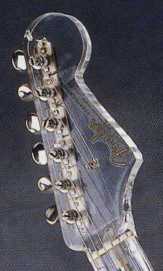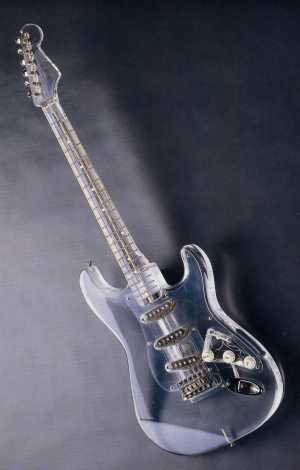|
The
Sensational Story of the See-Through Stratocaster«
The
Birth of the Stratocaster«
 Our story begins in the 1950's at the old Fender« factory
in South Raymond Avenue, Fullerton, California. In 1954, the
first Stratocaster« rolled off the production lines. This
iconic guitar was designed by Leo Fender with the collaboration
of musicians, notably local touring guitarist Bill Carson,
without whom the Strat«, in its present form, would not
exist.
Our story begins in the 1950's at the old Fender« factory
in South Raymond Avenue, Fullerton, California. In 1954, the
first Stratocaster« rolled off the production lines. This
iconic guitar was designed by Leo Fender with the collaboration
of musicians, notably local touring guitarist Bill Carson,
without whom the Strat«, in its present form, would not
exist.
Plans
for a see-through Strat«
In 1957, Carson
was involved in a top-secret Fender« project to build
a completely see-through Stratocaster«. Commissioned by
the then-head of sales, Don Randall, the purpose was twofold:
On the one hand, the finished article was to be taken on tour
around schools and museums in the United States, to educate
the nation's children on the inner workings of Leo Fender's
revolutionary Stratocaster« guitar. On the other hand,
a fully transparent guitar would be the first of its kind,
and would illustrate to the public, just how innovative and
amazing the Stratocaster« was, with its flexible truss
rod and state-of-the-art electronics.
The process of building
the see-through Strat« was a daunting one, and the factory
engineers' first task was to find a substance transparent
enough to enable the instrument's inner workings to be seen
clearly. The solution was found at the DuPont Corporation,
who, as well as being the nation's foremost manufacturer of
automobile paint, also supplied the custom paints for Fender«
guitars.
Lucite«
DuPont chemists
had discovered a polymer called methyl methacrylate (which
was among the first plastics derived from petrochemicals)
in 1931. The substance, which was eventually given the brand
name Lucite«, had a crystal-clear appearance and an amazing
strength that was far superior to any nitrocellulose-based
plastics. Lucite« was in heavy demand during World War
II for use in windshields, nose cones, and gunner turrets
for bombers and fighter planes. After the war, DuPont marketed
it for use in a variety of decorative and functional uses,
such as lamps, hairbrushes and jewellery.
 The Making of the See-Through Strat
The Making of the See-Through Strat
Although the construction
of the Lucite Strat« began in 1957, it took a painstaking
FOUR YEARS to complete. Because it was a unique guitar, it
had to be built completely by hand. Finally, in 1961, it was
ready to play. Although it was built to be played as well
as displayed, it was impractical for use as an instrument
due to its colossal weight – it weighed 18 lbs (8.18 kgs).
“The
Thousand Dollar Guitar”
The Lucite Strat
was given a serial number of 26860, which corresponds to a
guitar made in 1957/8. The tremolo arm, bridge unit and tuning
pegs were all gold plated and it was topped off with a pre-1959
eight-screw pickguard. The neck had a "V" profile.
This see-through
wonder was displayed at music trade shows, where it was billed
as “The Thousand Dollar Guitar!!!” and given pride of place
on the Fender« stand. After the first couple of shows,
the guitar had its gold hardware removed and replaced with
chrome parts, to improve its aesthetic value and keep it looking
new.
Mid-Sixties
Modifications
In 1965, the winds
of change blew through the company, and it was taken over
by the CBS Corporation. In the same year, the powers-that-be
at CBS decided for further modify the guitar by adding a CBS
neck plate and serial number of 77958, which corresponds to
an instrument made in 1965.
Science
Museum
The Lucite Strat«
was withdrawn as a trade show crowd pleaser and was lent to
a science museum in Tulsa, Oklahoma. During this time, the
guitar became the responsibility of Bill Carson, who, by now,
had been appointed Fender's Director of Artist Relations in
Nashville.
Nashville
Airport – the Last Public Sighting of the See-Through Strat«
After its stint
at the museum, the Lucite Strat« was mounted in a glass
case and displayed in the lobby of Nashville airport, where
it greeted the thousand of tourists and businessmen who flew
into the area. After a few months, the cost of displaying
the guitar as an advertisement for Fender« were considered
too high, and it was withdrawn. This was to be the last time
that the guitar would ever be displayed in public again.
The
Forgotten Guitar
Sadly, this magnificent
creation became something of a nuisance by the late 1960's.
It was too heavy to play and wasn't in keeping with the ideas
of the Fender/CBS Corporation. Unable to find a use for this
promotional oddity, Bill Carson stashed the Strat« under
his bed, where it lay unloved, unplayed and forgotten for
a good few years.
Sold!
Bill Carson evenually
sold the Lucite Strat« and some other Fender«-related
bits and pieces to guitar enthusiast and writer John Sprung
in the mid 1980's. (John's works include the excellent book,
Fender Amps – The First Fifty Years.) John played
the guitar a number of times and in his own words, the guitar
"played pretty well."
The
Guitar's Current Whereabouts
In 1990, John sold
it to a private collector, who still owns the guitar to this
day. Although it was originally billed as “The $1,000 Guitar”,
it is quite clearly worth substantially more than that sum
now. In a recent article in the U.S magazine, Guitar Player,
the Lucite Strat« was described as “The most valuable
non-celebrity solidbody Fender« ever made.”
As interest grows
in vintage and collectable Fender« guitars, it may well
be time for the Lucite Strat« to go on display once more.
Thanks
to Tom Wheeler and John Sprung for their assistance in writing
this article.
|



